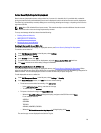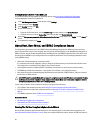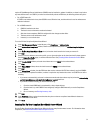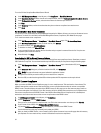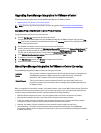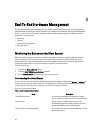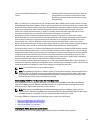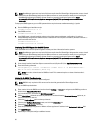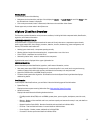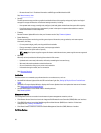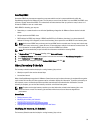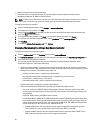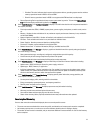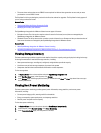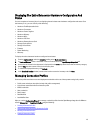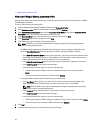
Viewing Events
To view events, do one of the following:
• Navigate to the virtual machine and right-click to display the vCenter → Tasks & Events tab and click Events so that
the selected level of events is displayed.
• Click on the parent node (cluster or datacenter) of the host or the root folder of the vCenter.
Events appear only on those nodes in the vSphere tree.
vSphere Client Host Overview
The Overview provides information on key host server attributes, including individual component health, identification,
hypervisor, and firmware information.
HARDWARE COMPONENT HEALTH
Component health is a graphical representation of the status of all major host server components: system chassis,
power supply, temperature, fans, voltage, processors, batteries, intrusion, hardware log, power management, and
memory. The available status states are:
• Healthy (green check mark) - component operating normally
• Warning (yellow triangle with exclamation point) - component has a non-critical error
• Critical (red X) - component has a critical failure
• Unknown (question mark) - status is unknown for the component
A global health status is displayed in the upper-right header bar.
SERVER INFORMATION
Server information provides identification, hypervisor, and firmware information, such as:
• Host name, power state, iDRAC IP, Management IP, connection profile in use, model, service tag and asset tag
numbers, number of days left on the warranty, and when the last inventory scan was performed.
• Hypervisor, BIOS firmware, and iDRAC firmware versions.
• Ten most recent system event log entries. Click Details to launch the System Event Log window that displays
additional log details.
Host Information
In the left pane of the Host Overview, you can find the links to the following types of Host information:
• System Event Log
Displays hardware system event log information. See, Understanding System Event Logs.
• Hardware Inventory
Displays information about the following hardware devices:
– Field Replaceable Units (FRUs) such as DIMMs, system planar, power supplies, backplanes, controller cards,
etc.
– Memory - Number of slots available and in use, maximum capacity and amount of memory in use, and details on
individual DIMMs.
– Network Interface Cards (NICs) - Number of installed cards and details on individual NICs.
– PCI Slots - Total available and number in use and details on individual slots.
– Power Supplies - Number present and details on individual PSUs.
– Processors - Number present and details on individual CPUs.
37



